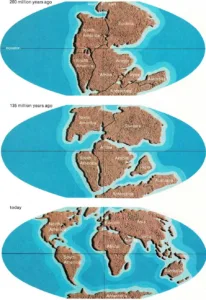
The moving continents
It may seem to you that the earth’s crust is a single piece of rock. You
may think this crust covers the outside of the earth just as an apple’s
skin covers an apple. But the earth’s crust is actually made up of a
number of enormous separate pieces, called plates. These plates fit
together, like the pieces of a puzzle. And they are all moving, very
slowly, in different directions.
Scientists are not sure what makes these huge, curved sheets of rock
move. They think the plates slide on the hot, soft rock beneath them.
The plates move from less than one inch (2.5 centimeters) to eight
inches (20 centimeters) a year.
Some of the plates make up part of the ocean floor. Others hold the high
masses of rock that rise above the sea and form the continents. As the
plates move, they carry the continents and ocean floor with them.
The plates have probably been moving for billions of years. This means
that the earth’s continents and seas have probably had many different
shapes. Scientists think that more than two hundred million years ago
the earth’s dry land was all bunched together, forming one gigantic
continent. Slowly, as the plates moved, the one huge continent broke
into two continents. And, as the plates continued to move, both of these
continents broke up to form the seven continents we know today.
As the plates keep moving, the continents and seas will keep changing
shape. Scientists think that in about fifty million years South America
and Africa will be farther apart than they are now. This will make the
Atlantic Ocean wider. And Australia may move up and push against
Southeast Asia, becoming part of it.

